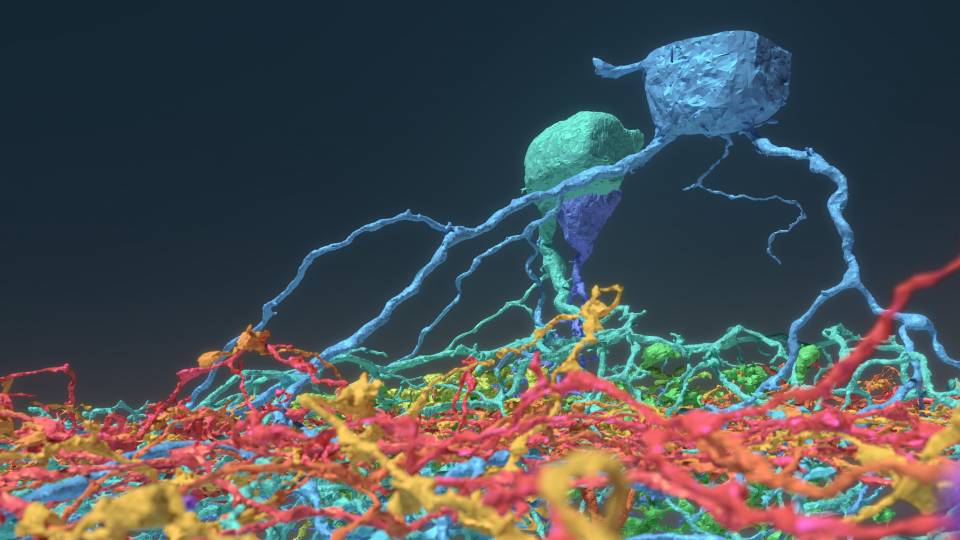When a group of people tries to decide how to carry out an important task, it is sometimes said that the pivotal discussions do not happen in large, well-attended meetings, but in one-on-one conversations around the water cooler.
It turns out that among individual neurons in our brains, the same may hold true.
Likening the process to the sort of casual conversations one might have at a cocktail party, William Bialek and his research team have found that retinal ganglion cells, the nerve cells along the back of our eyes that transmit visual signals to the brain, organize their actions based on communications they have with other individual cells rather than on group-style discussions. The findings, derived from experiments with and mathematical models of groups of 40 cells in the retinas of salamanders, could shed light on how brain cells work as a team.
“We have found that it is possible to understand the group behavior of neural cells based solely on knowledge of these pair interactions,” said Bialek, the John Archibald Wheeler/Battelle Professor in Physics at Princeton. “ From these pair-wise communications, a consensus emerges as to what message will be sent from the eye to the brain. But it comes from many small discussions, not one large one.”
The research paper, which Bialek wrote with Princeton colleagues Michael Berry, Ronen Segev and Elad Schneidman, appears in today’s (April 20) edition of the journal Nature.
“By eavesdropping on the ‘conversations’ of individual nerve cells, these researchers learned to predict how small groups of nerve cells in the eye would behave,” said Dr. C. John Whitmarsh, a biophysicist at the National Institute of General Medical Sciences, which supported the work. “This really is a fantastic result, and could help us understand how brain cells work together to make decisions.”
Retinal ganglion cells have often shed light on the workings of the brain, since the ganglion cells share many characteristics of cells deeper inside the brain. Unlike brain cells, however, they are more accessible for experiments and easily stimulated into action with light.
“We have these enormous networks of cells in our heads, and we are still just beginning to learn about how they communicate,” said Bialek, a theoretical physicist whose investigations cross over into neuroscience and mathematical approaches to other areas of biology. “The retina should be simpler than the cells that govern our deepest thoughts. But maybe the retina is a system that we actually can understand, and it will give us a way of thinking about the harder problems of understanding the brain as a whole.”
Under observation, even two retinal cells located right next to each other seem to be marching to different drummers rather than being coordinated very strongly. But when the team looked not at two cells but at larger groups of 10 or 40, there did seem to be strong patterns in which different groups of cells would suddenly act together.
“Since all four of us were educated as physicists, we looked for a mathematical way of describing what was going on,” Berry said. “We wanted a model that could capture both the near random character that one sees looking at two cells and the highly structured behavior of the whole group.”
From their modeling efforts, two possibilities emerged, both compelling to a limited degree. In one, the scientists imagined each cell as belonging to a number of “teams” whose full membership never appeared at once.
“Just as you might sit down to dinner with whatever members of your team happened to show up at the same time as you on a particular night, we thought the cells might fire in groups that way,” Schneidman said. “And just like students often participate in multiple activities, you might have cells on multiple teams. Altogether, this could produce random-looking behavior if you couldn’t see the team rosters.”
The other possibility was that no such groupings of retinal cells existed. Rather, the 40 cells behaved somewhat like a cocktail party, or people gathered around an office water cooler: Ideas are bandied about and overheard, snippets of information are passed on as conversation partners shift, and, as many one-on-one conversations occur, a collective plan gradually emerges.
“Eventually the second possibility seemed to fit the data better, but with a twist,” Schneidman said. “It seems that cells at the cocktail party talk primarily, perhaps exclusively, in pairs alone. No one belongs to a group, or takes dictation from a leader, but everyone bases their behavior on what we might call ‘informed pair conversations.’ They participate in as many of them as they can, listen as much as they can, then act.”
According to this analogy, the retinal cells would transmit messages based on the information culled from these “conversations.” However, Bialek said, as at any party, there are subtleties at work as well.
“Just as you might know from past experience that you tend to sympathize with one party guest quite often, but are put off by another, the opinions you draw from different conversations are not all weighted equally,” he said. “You might nod politely at one person’s argument, while agreeing strongly with another, even though they had both come down on the same side of an issue. Nerve cells seem to react to one another in the same way.”
The team was surprised by how far they could push these ideas, Berry said.
“The evidence pointed us to a more startling discovery, which is that buried in the apparent randomness there are subtle relationships between pairs in the group, and you can actually determine what the group’s decision will be, based solely on an awareness of these relationships between pairs,” he said. “Our model does not exclude the possibility that larger groupings within the 40 cells exist. What it shows is that either way, they do not need to be considered to predict the final outcome.”
Segev and Berry are pushing the technology of their experiments so that they will be able to listen in on up to 200 cells in the near future, partly in the hopes of testing these predictions.
“We all know biological systems, from the tiniest cell up to the largest whale, are more than the sum of their parts,” Bialek said. “The individual parts aren’t alive, but when they come together they are. It could be that this is horrendously complicated. But if what we have learned from the retina is more general, perhaps we can understand a lot just by knowing about the interactions between two parts at a time. Then we might be able to use our mathematical tools to understand how all of these pairs can add up to the whole: complex behavior arising from the simple principle of hanging out at the water cooler from time to time.”

